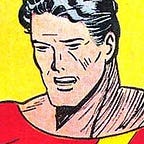Flash Fact: The secret origin of “Barry Allen”
Comics fans know the secret origin of DC Comics’ superhero The Flash: a lightning bolt strikes forensic scientist Barry Allen and a nearby shelf of chemicals, dousing Allen with lightning-charged chemicals that give him super-speed, which Allen uses to fight crime as The Flash. But Flash fans may not know that two influential entertainers inspired the name of The Flash’s alter ego, “Barry Allen.”
According to comics historian Bill Schelly in American Comic Book Chronicles: The 1950s, DC Comics editor Julius Schwartz, who oversaw the creation of the character in 1956, recalled that the “Flash’s secret identity of Barry Allen was a combination of two show business personalities he was fond of in those days, radio talk-show host Barry Gray and humorist Steve Allen.”
Barry Gray is celebrated as “the father of talk radio”; he is credited with creating the concept of the talk radio broadcast, in which the radio host talks about particular issues and invites listeners to call in with their opinions. Gray died in 1996.
Steve Allen was the first host of the NBC talk show The Tonight Show. Allen was a pioneer in developing the concept of the television talk show, and is remembered as a brilliant composer and comedian. Allen died in 2000.
As The Flash, Barry Allen is an extraordinary superhero; it is fitting that the character’s name is inspired by two extraordinary, pioneering entertainers.
NOTE: Schelly writes about Schwartz selecting the name “Barry Allen” on page 146 of American Comic Book Chronicles: The 1950s (TwoMorrows Publishing, 2013)
The images above are the property of their respective owner(s), and are presented here for nonprofit, educational purposes only under the fair use doctrine of the copyright laws of the United States of America.
